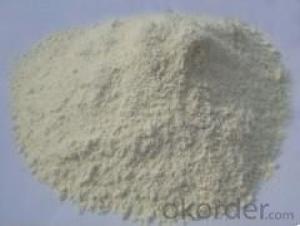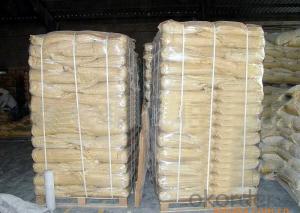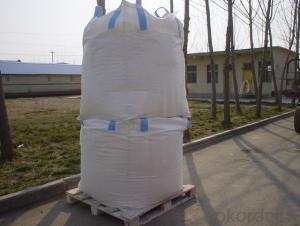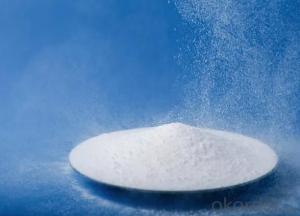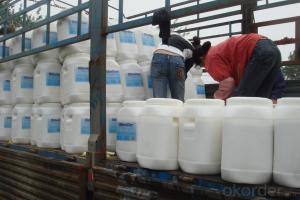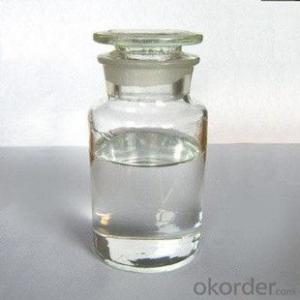RUBBER VULCANIZING ACCELERATOR NS Rubber Chemicals
- Loading Port:
- Tianjin
- Payment Terms:
- TT OR LC
- Min Order Qty:
- 25 m.t.
- Supply Capability:
- 12000 m.t./month
OKorder Service Pledge
OKorder Financial Service
You Might Also Like
RUBBER VULCANIZING ACCELERATOR TBBS(NS)
Chemical Name: N-Tertiarybutyl-2-benzothiazole sulfennamide
Molecular Formula:C11H14N2S2
Molecular Weight:238.37
CAS NO. : 95-31-8
Executive standard:GB/T21840-2008
Specification:
Item | Index |
Appearance | White or light yellow powder, granular |
Initial M.P,oC ≥ | 104.0 |
Loss on drying, % ≤ | 0.40 |
Ash, % ≤ | 0.30 |
Residues on 150μm sieve, % ≤ | 0.10 |
Insoluble in Methanol,% ≤ | 1.00 |
Free amine,% ≤ | 0.5 |
Properties: White or light yellow powder, granular. The density is 1.26-1.32. Soluble in benzene, methylene chloride, carbon tetrachloride, ethyl acetate, acetone, ethanol, dissolved gasoline, do not dissolve in water, acid, dilute alkali solution.
Application: Provides fast cure rate and high modulus development in NR, SBR, BR and blends. Normally used alone or with small quantities of ultra accelerators in tire compounds or industrial rubber products low poison and high efficiency. It is good back up for NOBS. Be regarded as standard accelerator.
Packaging: 25kg plastic woven bag, paper with plastic film bag, Kraft paper bag or jumbo bag
Storage: The product should be stored in the dry and cooling place with good ventilation, avoiding exposure of the packaged product to direct sunlight. The validity is 1 year
Note: The product could be ultra fine powder based on customer accurate requirement.
- Q:Chemistry why the catalyst can be equal to speed up the positive reaction rate
- Since the catalyst only changes the activation energy and the amount of reactivity can be reduced, the amount of reaction energy is also reduced. Therefore, a positive catalyst is also a good catalyst for its reaction. Speed up the same multiple.
- Q:What is a catalyst in a chemical reaction?
- Hi Ganah! A catalyst is a substance that increases the rate of a chemical reaction without itself being used up in the reaction. They lower the activation energy for a reaction and also speed up the rate of the reaction (both in reverse and forward reactions). Let's look at a generic chemical reaction: A + B---C + D C + D---B + E Here, the catalyst is substance B because it is part of the chemical reaction but then it is not used up in the net reaction. See how it seems to be used up in the first step, but by the second step, the catalyst is made once again. The net reaction is A + B--->B + E and you can see how it is not consumed in the reaction. There are also 3 types of catalysts. Heterogeneous catalysts are catalysts that are in different phases than the reactants. An example would be like a reaction between two solids but a liquid is added to speed up the reaction. The liquid is in a different state of matter than the solids but it can still function as a heterogeneous catalyst. Homogeneous catalysts are catalysts that are in the same states of matter as the reactants. An example would then be ethyl acetate reacting with water to form acetic acid and ethanol with an acidic catalyst. They would all be liquids. Lastly, there are enzyme catalysts. These are proteins in your body that speed up biological reactions by reacting with substrates. I hope this helped and good luck with chem!
- Q:Chemical equation if there is a catalyst and heating, which write in the equal sign above, which written in the following? Tomorrow academic level test, solution
- This do not care The But in general the catalyst is written on the equal sign is better ...
- Q:I need to name 3everyday catalysts for my chemistry homework. I don't want anything complicated there must just be 3 easy ones out there... Then could you please state what each one is used for? Please do it like this, e.g.Hello ; used to say hi to someone. I know that's a bad example but please!!
- Hello ; Chemical catalysts are substances that increase the rate of reaction (while remaining themselves chemically unchanged: Polyethylene, the polymer used to make everything from: 1. garbage bags and 2. grocery bags, to 3. squeezable bottles, to 4. cable insulation, is made by passing ethylene gas over a catalyst. Most other polymers are made in the same (or similar) way. Synthetic rubber, nylon, polyester, PVC, teflon, etc. It's not hard to think of 10 uses for these catalyst-produced materials alone... e.g. : 5. rain coats 6. pantyhose 7. water pipes 8. bouncy balls 9. non-stick surfaces and pads 10. saran wrap 11. food containers 12. cell-phone and laptop cases 13. cheap wigs 14. fishing line... 15. Enzymes are Biological catalysts: 16. beer and 17. bread are typically made with yeast, a living organism containing enzymes I hope this helps!
- Q:Chemical Reactions Under what circumstances the catalyst accelerates the reaction
- First, more than ninety-nine percent of the catalyst is accelerating the reaction, and if the catalyst kinetics reduces the energy barrier of the reaction, the reaction will naturally accelerate.
- Q:What are the characteristics of the catalyst in the catalytic reaction?
- The role of the catalyst in the chemical reaction is to change the rate of chemical reaction, and its own quality and chemical properties do not change.
- Q:i know that the catalyst is not react in an reaction,,,so that i don't why could it speed up the reaction?? Further, how does the scientist determine the catalyst for certain reaction??please give me more example....i really want to know it! i do not have any idea about this...so hope your answer will help me....thanks!
- Normal reaction requires much heat and energy but a catalyst provides a space where it can be done without either since provides space for both to bump into each other and stay till they bond..so catalyst is not involved in reaction but allowed it to occur at a much lower temp and energy.
- Q:High school stage which organic chemical reactions do not use catalyst
- Aldehyde and silver ammonia solution reaction, and the new system of Cu (OH) 2 reaction.
- Q:Just something I've always wondered about...
- transition okorder /... for ex-- X (one reactant) + catalyst(transition element) ------X.catalyst(intermediate unstable compound) X.catalyst + Y (other reactant) --------XY(product) + catalyst how the change in oxidation state of transition elements helps the reacton through the formation of intermediates may be seen from reaction in between SO2 and O2 to form SO3 in presence of V2O5 ... V2O5 + SO2 ------V2O4 + SO3 2V2O4 + O2 ------2V2O5 in the above reaction vanadium changes its oxidation state from +5 to +4 and again to +5.. another example is reaction in between iodide and persulphate ions in presence of Fe(III) as catalyst... 2I(-) + S2O8(2-) ---------I2 + 2SO4(2-) (Fe(III) is present as catalyst) the reaction is believed to take place as follows: 2Fe(3+) + 2I(-) ------2Fe(2+) + I2 2Fe(2+) + S2O8(2-) ------2Fe(3+) + 2SO4(2-) (3)in number of cases transition elements provide a suitable large surface area with free valencies on which reactants are absorbed ...as a result concentration of reactants on surface of catalysts increases..hence rate of reaction increases...this is known as adsorption theory.... according to adsorption theory : there are free valencies on surface of solid transition metals because of the incomplete d-subshelll.. so the mechanism of catalysis involve followin five steps: (1) diffusion of reactant molecules towards surface of catalyst... (2) adsorption of reactant molecules on surface of catalyst by forming loose bonds with catalyst due to free valencies... (3)occurence of chemical reactions between reactant and catalyst forming an intermediate.. (4)desorption of product molecules from surface due to its lack of affinity for the catalyst surface thereby making the surface free for fresh adsorption of reactant molecules... (5)diffusion of product molecules away from surface of catalyst...
- Q:Comparison of biocatalysts with chemical catalysts!
- 4, some of the catalytic activity of biological enzymes and related factors .5, most of the enzymes are proteins, which will be high temperature, strong acid, alkali and other broken
1. Manufacturer Overview |
|
|---|---|
| Location | |
| Year Established | |
| Annual Output Value | |
| Main Markets | |
| Company Certifications | |
2. Manufacturer Certificates |
|
|---|---|
| a) Certification Name | |
| Range | |
| Reference | |
| Validity Period | |
3. Manufacturer Capability |
|
|---|---|
| a)Trade Capacity | |
| Nearest Port | |
| Export Percentage | |
| No.of Employees in Trade Department | |
| Language Spoken: | |
| b)Factory Information | |
| Factory Size: | |
| No. of Production Lines | |
| Contract Manufacturing | |
| Product Price Range | |
Send your message to us
RUBBER VULCANIZING ACCELERATOR NS Rubber Chemicals
- Loading Port:
- Tianjin
- Payment Terms:
- TT OR LC
- Min Order Qty:
- 25 m.t.
- Supply Capability:
- 12000 m.t./month
OKorder Service Pledge
OKorder Financial Service
Similar products
New products
Hot products
Related keywords
